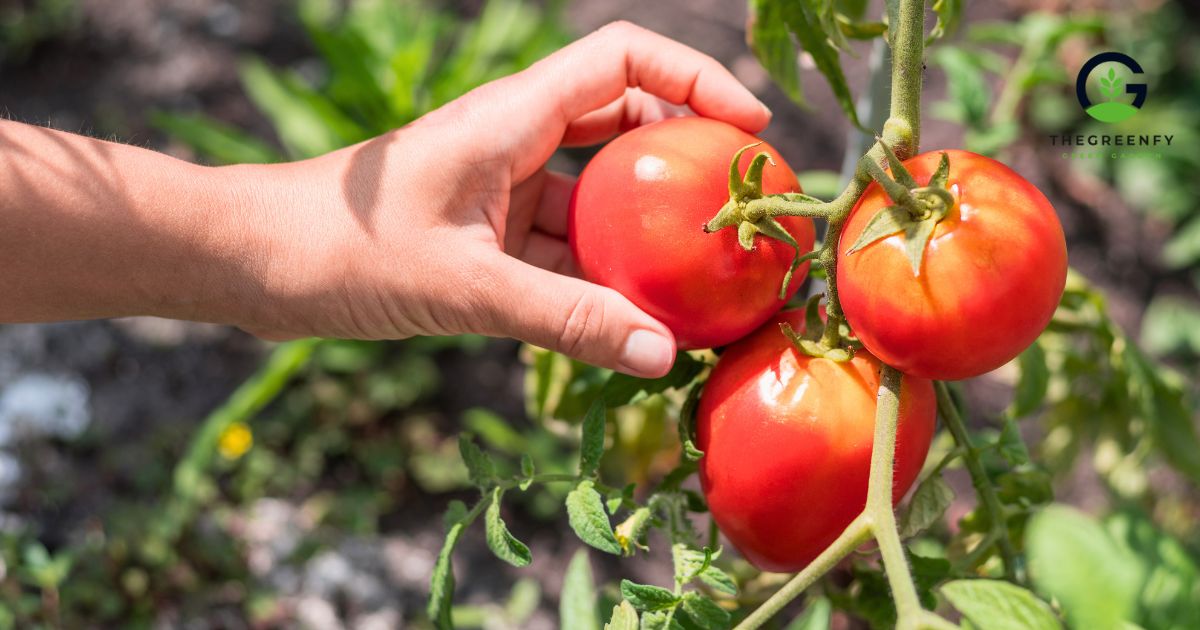Tomatoes are among the easiest and most rewarding vegetables (technically fruits!) to grow in your garden.
Whether you’ve got a sunny balcony, a raised bed, or a patch of backyard soil, you can grow tomatoes that taste a hundred times better than store-bought ones.
In this guide, I’ll walk you through every step of planting tomatoes, from choosing the right seeds to picking that juicy red tomato from your plant. Let’s dig in—literally!
Why Grow Your Tomatoes?
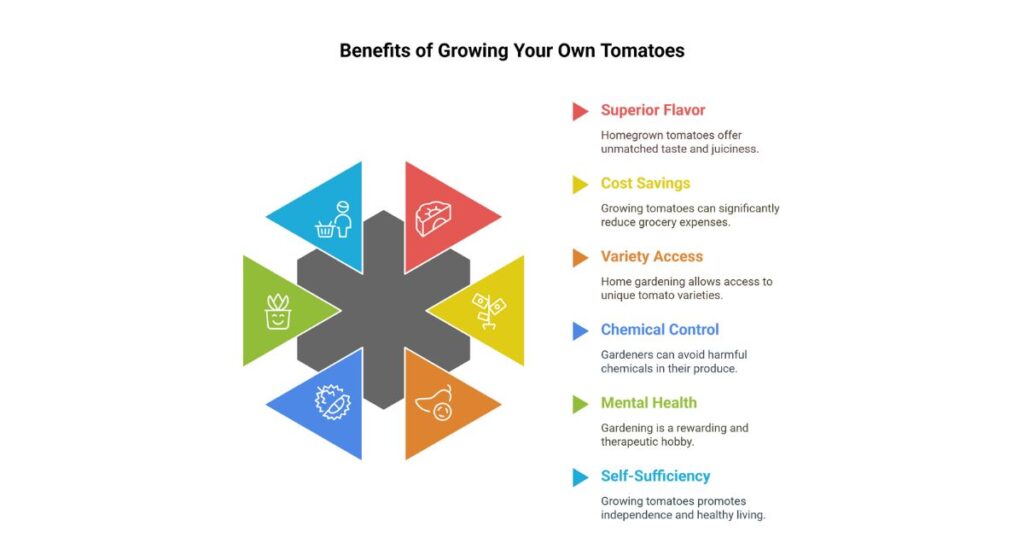
There’s something magical about growing your tomatoes. If you’ve only ever had tomatoes from the store, you haven’t tasted one yet.
Here’s why it’s worth planting your own:
1. Flavor That Store-Bought Can’t Match
Homegrown tomatoes are sweeter, juicier, and more flavorful than anything in a plastic grocery store clamshell. Why? Because most store tomatoes are bred for extended shelf life, not taste. You pick them at peak ripeness when you grow your own, not when they’re still green and hard.
“A tomato fresh from the garden is like summer sunshine in a bite.”
2. Save Money Without Sacrificing Quality
A single packet of seeds can yield dozens of pounds of fresh tomatoes. If you regularly buy tomatoes, especially organic or heirloom ones, growing your own can save you a good chunk of money over the summer.
3. Access to Unique Varieties
Ever heard of Green Zebra? Black Krim? Cherokee Purple? Most grocery stores only stock 1–3 types of tomatoes. Growing your own opens the door to hundreds of unique and delicious varieties you won’t find on shelves.
4. Fewer Chemicals, More Control
You get to control what goes into your soil and onto your plants. No harmful pesticides, no wax coatings—just fresh, real food. You can grow fully organic if you want.
5. A Fun and Rewarding Hobby
Gardening is great for mental health, and growing tomatoes is one of the most rewarding parts. Watching tiny seeds turn into a jungle of fruit-filled vines is a joy. Plus, it’s an excellent activity for kids and families.
6. A Step Toward Self-Sufficiency
Growing your own produce- even just tomatoes- feels empowering in a world where food prices and supply chains are unpredictable. It’s one small step toward more independence and healthier living.
Types of Tomatoes: Which One Should You Grow?
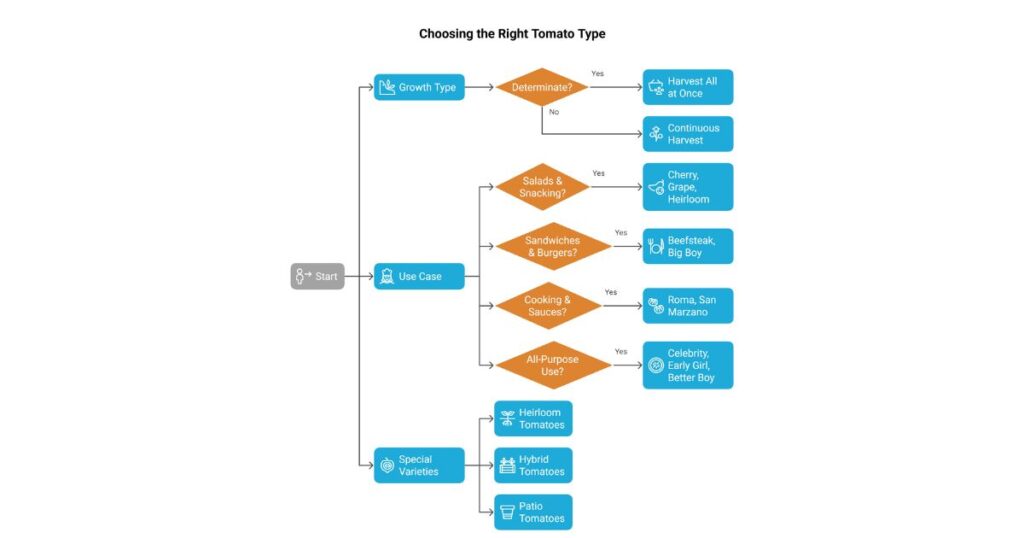
Before you plant, choosing the right type of tomato for your needs is essential. Tomatoes come in all shapes, sizes, and personalities.
Let’s break it down:
1. Growth Type: Determinate vs. Indeterminate
| Type | Growth Habit | Harvest Style | Best For |
| Determinate | Grows like a bush and stops growing when fruit sets. | All fruit ripens around the same time. | Containers, small gardens |
| Indeterminate | Grows like a vine and keeps growing all season. | Produces continuously until frost. | Trellises, larger garden beds |
- Go with determinate if you want a big harvest all at once—great for canning.
- Choose indeterminate if you prefer to pick fresh tomatoes throughout the summer.
2. By Use Case
Think about what you want from your tomatoes:
- For Salads & Snacking:
Cherry, Grape, or Heirloom
These are bite-sized and sweet. Perfect for tossing into salads or eating right off the vine. - For Sandwiches & Burgers:
Beefsteak or Big Boy
Large, meaty slices that don’t fall apart. Ideal for juicy bites. - For Cooking & Sauces:
Roma or San Marzano
These have fewer seeds and less juice, making them perfect for thick sauces or pastes. - For All-Purpose Use:
Celebrity, Early Girl, or Better Boy
These are versatile and easy to grow for beginners.
3. Special Varieties Worth Trying
- Heirloom Tomatoes: Old varieties passed down for generations. Known for flavor, color, and character.
- Hybrid Tomatoes: Bred for disease resistance, yield, and predictability. Good for beginners.
- Patio Tomatoes: Compact plants designed for small containers or balconies.
When to Plant Tomatoes
Timing is everything when it comes to planting tomatoes. These sun-loving plants won’t thrive if you start too early or too late.
Tomatoes Hate the Cold
Tomatoes are warm-weather crops. They won’t grow well in cold soil or when the nights are still chilly.
Here’s the golden rule:
Don’t plant tomatoes until all danger of frost has passed.
Even one cold night can shock the plants or stunt their growth. Wait until the soil is warm (above 60°F / 15°C) and night temperatures consistently stay above 50°F / 10°C.
Best Time by Growing Method
Let’s break it down:
- Starting from seeds indoors: Start your seeds 6 to 8 weeks before your last spring frost date. Use a seed-starting tray or small pots and keep them near a sunny window or under grow lights.
- Transplanting seedlings outdoors: Move your plants outside 2 weeks after your last frost. By this time, the soil should be warm and the nights mild.
- Direct sowing in the ground (not recommended): You can sow seeds directly in the garden after the frost, but it’s not ideal. Tomatoes need warmth to germinate and grow strong, so starting indoors gives them a head start.
How to Find Your Frost Date
Are you not sure when your last frost is? Just Google “last frost date + your city” or check with a local gardening center. This date will guide all your planting schedules.
Where to Plant Tomatoes
Tomatoes love a good spot. Picking the correct location is half the battle.
Sun, Sun, and More Sun
Tomatoes are sun worshipers. They need at least:
6–8 hours of full sunlight every single day.
The more sun they get, the better they grow. If you can give them 10–12 hours, that would be even better!
Avoid shady spots. A little morning sun or dappled light won’t cut it. Tomatoes need the full force of the sun to thrive and produce fruit.
Soil: The Foundation of a Happy Plant
Tomatoes like well-draining, fertile soil.
Here’s what your soil should have:
- Rich in organic matter (add compost or aged manure)
- pH between 6.0 and 6.8
- Loose and crumbly texture, not hard or compacted
Tip: Mix compost, bone meal, and crushed eggshells a week before planting.
You can do a quick soil test kit (available at garden stores) to check pH and nutrients.
Raised Beds, In-Ground, or Containers?
Tomatoes grow well in all three. It just depends on your space.
| Method | Pros | Considerations |
| In-Ground | Holds water longer, suitable for many plants | Needs good soil and spacing |
| Raised Beds | Better drainage, warms up faster | May dry out quicker, with more watering |
| Containers | Great for patios or balconies | Must be at least 5 gallons in size |
Container tip: Use dwarf or patio tomato varieties if space is tight. Make sure containers have drainage holes.
Avoid Bad Spots
Never plant tomatoes in areas where you have grown tomatoes:
- Potatoes
- Eggplants
- Peppers
These are all part of the nightshade family and can leave diseases affecting tomatoes behind. Rotate your crops every year to avoid soil-borne issues.
Sheltered, Not Smothered
Choose a spot that gets plenty of airflow, but not too windy. Good air movement prevents disease, but too much wind can break stems or dry the soil.
If your garden is exposed, consider planting near a fence, trellis, or wall that offers some protection.
Step-by-Step: How to Plant Tomatoes (Beginner’s Full Guide)
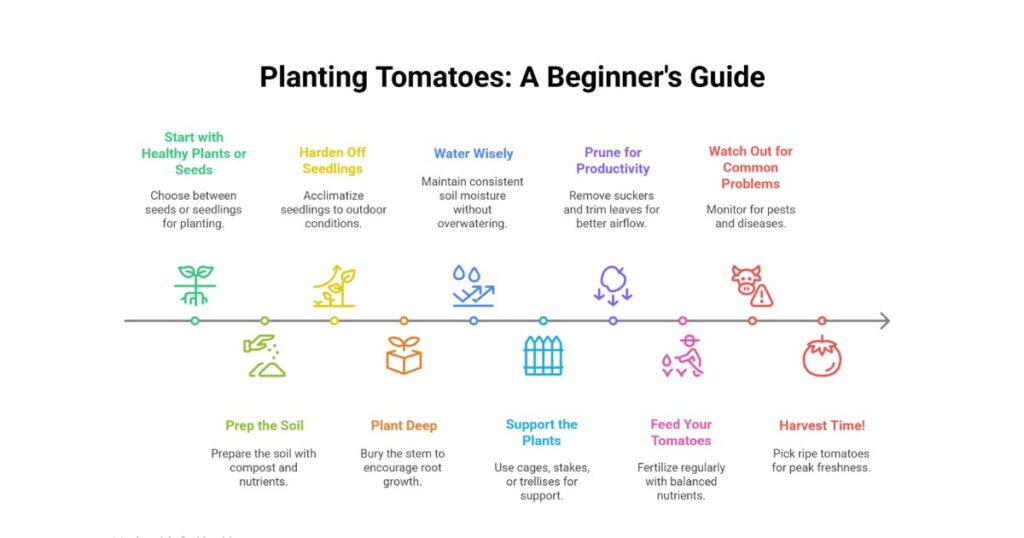
Planting tomatoes isn’t rocket science, but it’s not a total walk in the park. You need a plan, some patience, and a little love.
Follow these 10 simple steps, and you’ll be well on your way to juicy, flavorful tomatoes growing right outside your door.
Step 1: Start with Healthy Plants or Seeds
The foundation of sumptuous tomatoes starts with vigorous plants. You have two options here: seeds or seedlings.
Option A: Starting from Seed
Starting from seed gives you more variety and control. You can choose from hundreds of heirloom types, and it’s cheaper in the long run.
Here’s what to do:
- Start seeds indoors 6–8 weeks before your last frost date.
- Use a seed-starting mix, not garden soil. It’s lighter and drains better.
- Keep them in a warm spot (70–80°F) to germinate.
- Give them plenty of light. A sunny windowsill works, or use grow lights 12–16 hours daily.
Once your seedlings grow their first set of true leaves, move them to individual pots so they can develop stronger roots.
Option B: Buying Transplants
Not into the idea of babying seeds? No problem.
Just buy healthy seedlings from a nursery:
- Look for short, bushy plants, not tall and spindly ones.
- Avoid yellowing leaves or signs of pests.
- Choose local nurseries if possible, they usually stock varieties that do well in your area.
Step 2: Prep the Soil
Tomatoes are heavy feeders. To produce a big, tasty harvest, you’ve got to give them rich, healthy soil.
How to Prepare the Soil:
- Loosen it up. Use a shovel or garden fork to turn the soil 10–12 inches deep.
- Add compost. Mix in 2–3 inches of compost or aged manure.
- Boost nutrients. Add organic tomato fertilizer or a balanced 5-10-5 mix.
- Add calcium. Crushed eggshells or garden lime help prevent blossom end rot.
“Think of your soil like a buffet. If it’s packed with nutrients, your tomatoes will thrive.”
Check Your pH
Tomatoes like slightly acidic soil (pH 6.0–6.8). Use a basic soil test kit to check and adjust the soil if necessary.
Step 3: Harden Off Your Seedlings
This step is critical and often skipped.
Your tomato seedlings have been living a cushy indoor life. If you toss them into the garden without warning, they’ll get sunburned, wind-whipped, and stressed.
How to Harden Off:
- Start about 7–10 days before transplanting.
- Place plants outside in a shady spot for a few hours each day.
- Gradually increase sunlight and exposure time each day.
- If it’s cold, bring them inside at night for the first few days.
By the end of the week, your plants will be ready for the great outdoors.
Step 4: Plant Deep.
Here’s a cool tomato trick: they grow roots along their buried stems.
So, unlike most plants, you want to plant tomatoes deep.
How Deep to Plant:
- Remove the lower leaves from the bottom 1/3 of the plant.
- Dig a deep hole or trench, and bury the stem to the first set of healthy leaves.
- Roots will grow from the stem, giving the plant more support and access to water.
“A deep-planted tomato is a strong tomato.”
Spacing Tips:
- Determinate types: 18–24 inches apart
- Indeterminate types: 24–36 inches apart
- Rows: Space rows about 3 feet apart
Give them room to grow and breathe.
Step 5: Water Wisely
Tomatoes are picky about water. They need just the right amount—not too little, not too much.
Basic Watering Rules:
- Water at the base. Don’t wet the leaves. Wet foliage = disease.
- Water deeply. Encourage deep roots by soaking the soil 6–8 inches.
- Water in the morning. Gives leaves time to dry during the day.
How Often?
- Young plants: Every 2–3 days
- Mature plants: Once or twice a week (depending on weather)
Use mulch (straw, wood chips, or grass clippings) to keep soil moist and stop weeds.
Step 6: Support the Plants
Tomato vines are not vigorous on their own. Without help, they sprawl, break, and rot on the ground.
3 Main Support Options:
| Method | Best For | Notes |
| Tomato cages | Beginners, bush types | Easy to use, just place around the plant |
| Stakes | Small spaces, tidy look | Tie plants loosely every 6–8 inches |
| Trellises | Indeterminate types | Needs regular pruning and tying |
Use soft ties like fabric strips, twine, or tomato clips. Don’t tie too tightly or you’ll damage the stem.
“Think of supports like training wheels—your tomatoes need them to stand tall.”
Step 7: Prune for Productivity
Not all tomatoes need pruning, but indeterminate varieties greatly benefit from it.
Why Prune?
- Helps airflow = fewer diseases
- Directs energy to the fruit, not the extra leaves
- Keeps the plant manageable
How to Prune:
- Remove suckers – These are the little shoots that grow between the main stem and branches.
- Trim bottom leaves – Once the plant gets tall, remove the lower 6–12 inches of leaves.
- Don’t overdo it. Keep enough leaves to protect the fruit from sunburn.
“Less leaf, more tomato.”
Step 8: Feed Your Tomatoes
Tomatoes are heavy feeders, and regular meals = juicy fruit.
Fertilizing Schedule:
- At planting: Mix in compost and a balanced fertilizer (like 10-10-10)
- When flowers appear: Switch to a low-nitrogen fertilizer (like 5-10-10)
- Every 2–3 weeks: Feed throughout the growing season
Too much nitrogen = big leaves, little fruit.
Organic Feeding Options:
- Fish emulsion
- Seaweed extract
- Compost tea
- Banana peel water
Whatever you use, water it in well.
Step 9: Watch Out for Common Problems
Tomatoes are popular… but not just with gardeners. Bugs and diseases love them, too.
Common Pests:
- Aphids: Tiny green or black bugs on new growth
- Tomato hornworms: Big green caterpillars that eat leaves fast
- Whiteflies: Tiny white flies on the undersides of leaves
Solution: Spray with neem oil or insecticidal soap. To repel pests, plant companion plants (like basil and marigold).
Common Diseases:
| Disease | Symptoms | Fix |
| Blight | Yellow spots, leaf drop | Remove leaves, improve airflow |
| Blossom end rot | Black sunken spots on fruit | Add calcium and water consistently |
| Powdery mildew | White powder on leaves | Neem oil, prune the lower leaves |
Keep leaves dry. Mulch well. Rotate crops yearly.
Step 10: Harvest Time!
You’ve watered, fed, and babied these plants. Now comes the best part—harvest!
When to Harvest:
- The tomato should be fully colored (red, orange, yellow, etc.)
- Should feel slightly firm but not hard
- If it slips off the vine easily, it’s ready.
Don’t wait too long. Overripe tomatoes attract bugs and split on the vine.
“Pick in the morning for peak freshness and flavor.”
How to Harvest:
- Use your hands and gently twist the fruit off the vine
- Or use clean garden scissors to snip the stem.
- Handle gently to avoid bruising.
What If They’re Not Fully Ripe?
No problem. Pick them and let them ripen indoors in a warm, bright spot (not the fridge!).
How Long Does It Take to Grow Tomatoes?
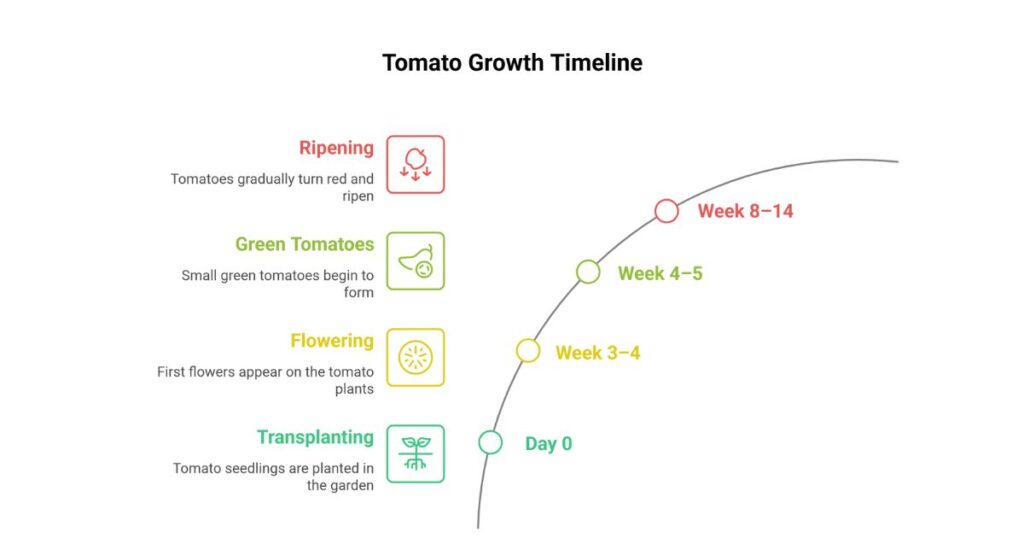
So, you’ve planted your tomato babies and wonder, “When will I get tomatoes?” Great question!
Tomatoes don’t rush. They take their sweet time. But if you plant them right and care for them, they’ll reward you big time.
Average Timeframe
Depending on the variety, it usually takes 60 to 100 days to harvest ripe tomatoes from the moment you plant the seed.
Let’s break it down:
| Tomato Variety | Days to Maturity | Best For |
| Cherry | 55–65 days | Fast harvest, plentiful for snacking |
| Roma (Plum) | 70–80 days | Ideal for sauces and canning |
| Beefsteak | 80–90 days | Thick slices for burgers/sandwiches |
| Heirloom | 75–90+ days | Incredible flavor, slower growing |
Pro Tip: Always check the seed packet or plant tag for “days to maturity.” This tells you how long it will take from transplanting (not seed-starting) to your first ripe fruit.
Factors That Affect Growth Time
Tomatoes grow faster—or slower—based on a few things:
- Sunlight: They need 6–8 hours minimum. More sun = faster growth.
- Soil health: Rich, nutrient-packed soil speeds up development.
- Watering consistency: Inconsistent watering can stress the plant and delay fruiting.
- Temperature: Tomatoes grow best between 70°F and 85°F during the day. Cold nights or heat waves can slow them down.
When Will You See Fruit?
- Flowers appear about 3–4 weeks after transplanting.
- Green tomatoes show up shortly after flowering.
- Depending on the type and weather, they take 20–30 more days to ripen.
So if you’re staring at your tomato plant every day and it’s leafy, be patient. It’s working underground and within its stems to give you a perfect harvest.
What to Do After Harvest
You did it. You grew tomatoes. You picked them. You probably took a picture or two—and now you’re wondering, “What’s next?”
After the harvest, here’s how to make the most of your tomatoes and garden.
1. Store Tomatoes the Right Way
Do NOT refrigerate fresh tomatoes. It ruins the flavor and texture. Keep them:
- At room temperature
- Stem side down on the counter
- Away from direct sunlight
Let any green or orange tomatoes ripen fully before eating.
2. Use Them While They’re Fresh
Tomatoes are super versatile. Here are quick and easy ways to use them:
- Fresh: Slice onto sandwiches, salads, and toast.
- Cooked: Make homemade pasta sauce, tomato soup, or salsa.
- Roasted: Oven-roasted tomatoes add deep flavor to pizzas or pasta.
- Juiced: Make fresh tomato juice or Bloody Mary mix.
“When you taste a warm tomato from your garden, plain with a sprinkle of salt, you realize store tomatoes don’t even come close.”
3. Preserve the Extra Bounty
Sometimes, you’ll get more tomatoes than you can eat. That’s a good problem to have.
Here’s how to preserve your harvest:
- Freeze: Wash, core, and toss them into freezer bags. Use later in soups or stews.
(Bonus: No need to peel before freezing!) - Can: Make batches of tomato sauce, salsa, or diced tomatoes. Water bath or pressure canning both work great.
- Dry: Slice cherry tomatoes and dry them in a dehydrator or oven to make your sun-dried tomatoes.
- Ferment: Try lacto-fermenting cherry tomatoes with garlic, salt, and herbs. It’s tangy and packed with probiotics.
4. Save Seeds for Next Season
Love how your tomatoes turned out? Save the seeds!
Here’s how:
- Scoop seeds from the best tomato.
- Ferment them in water for a few days to remove the gel coating.
- Dry thoroughly on paper towels.
- Store in a labeled envelope in a cool, dry place.
This way, you can grow your favorite tomato variety year after year—for free.
5. Clean Up and Prep for Next Year
Once tomato season ends:
- Remove old plants and dispose of them (especially if they had any disease).
- Clear mulch and compost it if it’s disease-free.
- Amend the soil with compost or aged manure to keep it healthy.
- Rotate crops next year to prevent soil-borne diseases. Don’t plant tomatoes in the same spot for 2–3 years.
“The end of this tomato season is the beginning of next year’s success.”.
Conclusion: Grow Your Best Tomatoes Ever
Growing tomatoes isn’t just about food—joy, patience, and watching something thrive under your care.
Every step is worth it from that first seedling to the moment you bite into a warm, juicy tomato fresh from the vine.
Whether growing in a backyard garden, on a sunny balcony, or in raised beds, you can grow amazing tomatoes with just a little effort and love.
Remember:
- Start with healthy plants.
- Plant deep, feed well, and support them.
- Give them sunshine, water, and attention.
Even if your first season isn’t perfect, don’t give up. Every tomato gardener learns something new every year.
So get your hands dirty, soak up the sun, and grow the best tomatoes of your life.
FAQs: How to Plant Tomatoes
Q1. Can I grow tomatoes in pots or containers?
A: Yes! Tomatoes grow well in containers if the pot is at least 5 gallons. Use well-draining soil and water regularly, and choose compact or determinate varieties like ‘Bush Early Girl’ or ‘Patio Princess.’
Q2. How many tomato plants should I grow for a small family?
A: For a family of 2–4, planting 3–5 tomato plants is usually plenty. If you love sauces or plan to preserve tomatoes, plant more!
Q3. Why are my tomato leaves turning yellow?
A: Yellow leaves could mean:
- Overwatering or underwatering
- Lack of nutrients (like nitrogen)
- Disease or pests
Check your watering schedule, fertilize regularly, and inspect for bugs or spots on the leaves.
Q4. Should I pinch off tomato flowers early on?
A: If your plant is small and newly transplanted, yes. Pinching off early flowers helps the plant focus on root growth first. Let the flowers grow after a week or two, and fruit will follow.
Q5. What can I plant next to tomatoes?
A: Great companion plants for tomatoes include:
- Basil – boosts flavor and repels pests
- Marigolds –keep bugs away
- Garlic & onions – deters aphids.
- Carrots & lettuce – fit nicely around tomato plants
Avoid planting near corn, potatoes, or fennel.
Q6. How do I know if my tomato is ripe?
A: A ripe tomato will be:
- Fully colored (red, orange, yellow, etc.)
- Slightly soft to the touch
- Easy to twist off the vine
Avoid refrigerating fresh-picked tomatoes. Let them ripen at room temperature for the best flavor.
Q7. Can I grow tomatoes year-round indoors?
A: You can, but it’s tricky. Tomatoes need 12–16 hours of light and consistent warmth. Try it if you have strong grow lights, good airflow, and patience. Cherry or dwarf varieties are best for indoor growing.
